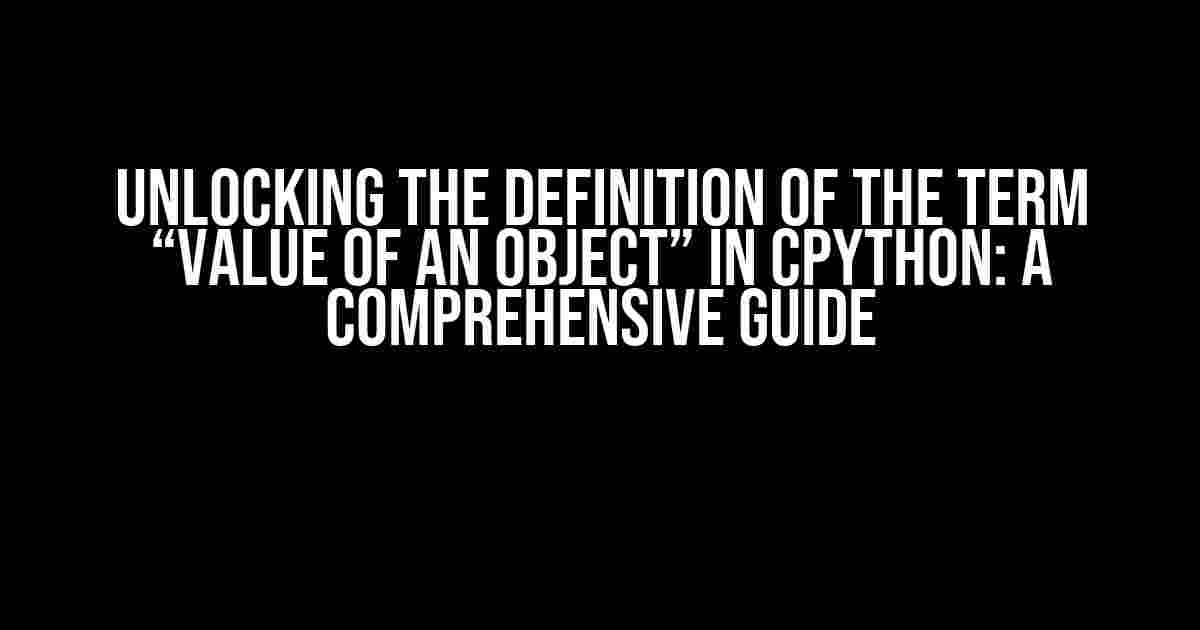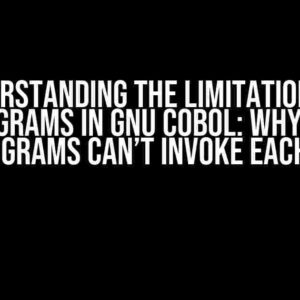Are you tired of scratching your head every time you come across the term “value of an object” in CPython? Do you find yourself lost in a sea of technical jargon, struggling to grasp the concept? Fear not, dear reader, for this article is here to demystify the definition of the term “value of an object” in CPython, providing you with a crystal-clear understanding of this essential concept.
What is the Value of an Object?
In CPython, an object is an instance of a class, and it represents a real-world entity or concept. Think of objects as containers that hold data and behavior. The value of an object, on the other hand, refers to the actual data stored within the object. In other words, it’s the contents of the container.
class Dog:
def __init__(self, name, age):
self.name = name
self.age = age
my_dog = Dog("Fido", 3)
print(my_dog.name) # Output: Fido
print(my_dog.age) # Output: 3
In the above example, my_dog is an object of the Dog class, and its value consists of the strings “Fido” and the integer 3, which are stored in the name and age attributes, respectively.
Understanding Mutability and Immutability
In CPython, objects can be either mutable or immutable. This distinction is crucial when it comes to understanding the value of an object.
Mutable Objects
Mutable objects are those whose value can be modified after creation. Lists, dictionaries, and sets are examples of mutable objects.
my_list = [1, 2, 3]
my_list.append(4)
print(my_list) # Output: [1, 2, 3, 4]
In the above example, the list my_list is a mutable object, and its value can be modified by adding a new element using the append method.
Immutable Objects
Immutable objects, on the other hand, are those whose value cannot be modified after creation. Strings, integers, and tuples are examples of immutable objects.
my_string = "hello"
my_string.upper()
print(my_string) # Output: hello (unchanged)
In the above example, the string my_string is an immutable object, and its value remains unchanged even after calling the upper() method.
How to Access and Modify the Value of an Object
Now that we’ve covered the basics, let’s dive into the nitty-gritty of accessing and modifying the value of an object.
Attributes and Properties
In CPython, objects have attributes and properties that can be accessed and modified using dot notation.
class Car:
def __init__(self, color):
self.color = color
my_car = Car("red")
print(my_car.color) # Output: red
my_car.color = "blue"
print(my_car.color) # Output: blue
In the above example, we access and modify the color attribute of the my_car object using dot notation.
Methods and Functions
Objects can also have methods and functions that can be used to modify their value.
class BankAccount:
def __init__(self, balance):
self.balance = balance
def deposit(self, amount):
self.balance += amount
def withdraw(self, amount):
self.balance -= amount
my_account = BankAccount(1000)
my_account.deposit(500)
print(my_account.balance) # Output: 1500
my_account.withdraw(200)
print(my_account.balance) # Output: 1300
In the above example, we define a BankAccount class with methods deposit and withdraw that modify the balance attribute of the object.
Best Practices for Working with Object Values
Here are some best practices to keep in mind when working with object values in CPython:
- Use meaningful attribute names: Choose attribute names that accurately reflect the data they represent.
- Document your code: Use docstrings and comments to explain the purpose and behavior of your objects and their attributes.
- Avoid mutable default arguments: Mutable default arguments can lead to unexpected behavior and bugs.
- Use immutable objects when possible: Immutable objects can help ensure data integrity and prevent unintended modifications.
- Test your code thoroughly: Write comprehensive tests to ensure your objects behave as expected.
Conclusion
In conclusion, the value of an object in CPython refers to the actual data stored within the object. Understanding the concept of mutability and immutability is crucial when working with objects, as it affects how their value can be modified. By following best practices and using meaningful attribute names, documenting your code, avoiding mutable default arguments, using immutable objects when possible, and testing your code thoroughly, you can ensure that you’re working with object values effectively and efficiently.
Remember, practice makes perfect, so be sure to experiment with different object types and scenarios to solidify your understanding of the value of an object in CPython.
Additional Resources
If you’re eager to learn more about CPython and object-oriented programming, here are some additional resources to get you started:
| Resource | Description |
|---|---|
| Python Documentation: Classes | Official Python documentation on classes and object-oriented programming. |
| Python Tutorial for Beginners: Classes and Objects | YouTube tutorial on classes and objects in Python. |
| PEP 8: Style Guide for Python Code | Official Python style guide for writing readable and maintainable code. |
Frequently Asked Questions
Q: What is the difference between an object’s value and its identity?
A: An object’s value refers to the actual data stored within the object, while its identity refers to its unique memory address.
Q: Can I change the value of an immutable object?
A: No, immutable objects cannot be modified once created.
Q: How do I check if an object is mutable or immutable?
A: You can use the id() function to check if an object’s value changes after modification. If the value changes, it’s mutable; otherwise, it’s immutable.
We hope this comprehensive guide has helped you understand the definition of the term “value of an object” in CPython. Happy coding!
Frequently Asked Question
Get ready to unlock the secrets of CPython and discover the true meaning of the “value of an object”!
What is the “value of an object” in CPython, and why is it important?
In CPython, the “value of an object” refers to the actual data or content stored in the object, rather than the object itself. This distinction is crucial because objects are mere containers, and their values are what give them meaning. Think of it like a labeled box: the box is the object, and the treasure inside is the value. Understanding this concept is vital for working with objects in CPython.
Is the “value of an object” the same as the object’s identity?
Nope! In CPython, an object’s identity is its unique address in memory, whereas its value is the actual data stored at that address. Think of identity as the object’s “name tag” and value as the treasure inside. Two objects can have the same value but different identities, just like two people can have the same name but be different individuals.
How is the “value of an object” different from its attributes?
In CPython, an object’s attributes are additional data stored alongside the object’s main value. Attributes are like stickers on the labeled box, providing extra information about the treasure inside. The value is the core content, while attributes are secondary details. For example, a Person object might have a value of “John Doe” and attributes like “age” and ” occupation”.
Can I change the “value of an object” in CPython?
It depends on the object’s type! In CPython, some objects, like lists and dictionaries, are mutable, meaning their values can be modified. However, other objects, like strings and tuples, are immutable, meaning their values cannot be changed. Try to modify an immutable object, and you’ll create a new object with the updated value instead!
Why is understanding the “value of an object” crucial for CPython developers?
Mastering the concept of object values is vital for writing efficient, effective, and bug-free code in CPython. It helps you navigate the complexities of object-oriented programming, makes debugging easier, and ensures that your code behaves as expected. By grasping the nuances of object values, you’ll become a CPython ninja, slicing through coding challenges like a pro!




